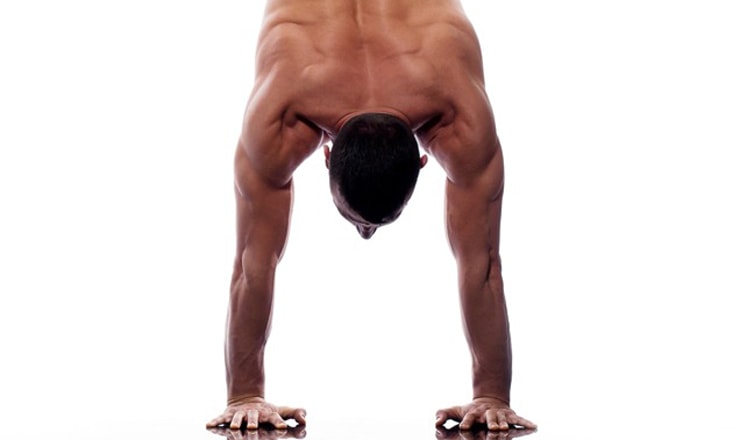Short edge of mat against wall. Downward-Facing Dog. Engage fingers, gripping down into the mat. Strengthen muscles in the arms and integrate arms into shoulder sockets.
Start to walk feet toward hands, aiming to stack hips above shoulders, but not getting anywhere close to that. Extend left leg toward the ceiling—or, more realistically, toward the back of the room. Bend right knee and begin to hop on right foot as left leg kicks up.
Envision gracefully lifting up into a yoga handstand. In actuality, panic as soon as torso comes anywhere near perpendicular to the floor.
Hi! My name is Kat, and I'm terrified of handstands.
If I'm being honest, it's not only Adho Mukha Vrksasana (Handstand) that instills sheer panic in me.
Pretty much all inversions do, except Headstand (at the wall, thankyouverymuch) and Shoulder Stand. And to be honest, the latter just makes my neck cranky unless I’ve got more than my fair share of blankets stacked beneath me.
What is it with being upside-down?
Here's the thing: I know that my arms can support my body weight.
I mean, I'm a fan of arm balances in my practice, and I mostly do them without fear of falling on my face. Why is it, then, that I feel like as soon as I enter the realm of the yoga handstand, my arms will collapse underneath me and I'll break my neck? It doesn't make any sense, and yet, here I am.
Since I'm tired of being the only person in class who's too afraid to even attempt kicking up at the wall, I'm ready to start taking action and facing my upside-down fears.
Take action—face your yoga handstand fears!
So I did it. I signed up for an arm balancing and inversions workshop at a local yoga studio. If you're feeling like there isn't enough support in an open class, a workshop is a great option to get insights and tips on a specific aspect of the yoga practice, and how it works in your body.
But what if you find out that the workshop has been canceled?
Don't use a change in your original plan as an excuse to avoid something that scares you. Get creative and set up an alternative to keep working with your fear. I actually set a time to get assistance from a yoga teacher friend, who rescheduled the session. And rescheduled again. And again.
So what to do? How about give up on that idea, and have a breakthrough anyway. While external support is useful and has its place, seeking out information yourself and trusting in your instincts and abilities is important and allows you to grow.
Get there… slowly.
Since I'm the kind of person who doesn't mind taking matters into my own hands (in this case, quite literally), I started thinking about the anatomy of Headstand versus Forearm Stand.
I recalled that during my teacher training, one of my friends pointed out how easily I could lift my head up off the ground thanks to the strength of my arms and shoulders. If I could do that, why couldn't I transition from Headstand to Forearm Stand that way?
My first attempt was, well, a flop. With my head up, I fell down trying to bring my hands from interlaced to flat on the floor. However, since it almost worked, I decided to try kicking up.
My boyfriend—ever patient with my need to talk through asana—agreed to help me out as a spotter, only intervening at my request.
He gave me the eyes I needed to see what my body was actually doing, and after a few attempts, I managed to kick up into Forearm Stand—something that had never happened before in my life without a strong assist.
It's all in your head.
I want to tell you that next I tried kicking up into Handstand, and it totally worked. I mean, I did try kicking up into Handstand, but it didn't happen. Not even close.
So I did what any yogi with a goal and an internet connection would do: YogaGlo. I found a Noah Maze class about overcoming the physical and mental barriers to Handstand. With an open mind, I followed his instructions, isolating muscle groups and focusing on my breath.
I tried kicking up into Handstand. I still panicked.
Instead of growing discouraged, I remembered some recent moments in my practice: my first Eka Pada Koundinyasana (an arm balance), my first Urdhva Dhanurasana without an assist, and that kick up into Forearm Stand.
They all came the same way: I slowly built strength and flexibility over time, working incrementally, and then one day, when I didn't expect it, I had the pose.
Do your practice and all is coming.
Although I wish I could tell you that my relationship with Handstand has now magically transformed, I can't. I'm still nervous, still unsure how to trust my arms to support my entire body upside-down on my hands.
I'm not grasping now, though. I'm watching every video I can find online to break down the mechanics of handstand. I'm practicing the little hops that I can, even if they barely bring my feet off the floor right now. I'm building trust in myself, and I know that when I'm ready, Handstand will come.
Until then: Short edge of mat against wall. Downward-Facing Dog. Engage fingers…


